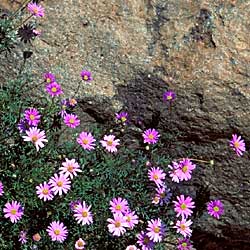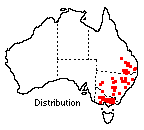
 |
Growing Native Plants |
 The
beautiful Brachyscome multifida, Cut-Leafed Daisy, is a perennial herb
found in the grassy understories of woodlands and open forests. It is naturally
distributed throughout the temperate areas of southern Queensland, New South
Wales and Victoria, however it is limited by the seasonal dryness to the north
and the colder climates of the south.
The
beautiful Brachyscome multifida, Cut-Leafed Daisy, is a perennial herb
found in the grassy understories of woodlands and open forests. It is naturally
distributed throughout the temperate areas of southern Queensland, New South
Wales and Victoria, however it is limited by the seasonal dryness to the north
and the colder climates of the south.
 It
is a member of the Asteraceae family; which is broken up into three subfamilies
and 17 tribes. Brachyscome multifida is in the tribe Astereae along with
about 15 other genera in Australia. Two varieties are recognised, B. multifida
var. multifida and B. multifida var. dilatata. The main
difference between these two varieties is the variation in the leaf shape. B.
multifida var. multifida has very narrow pinnate leaves about 3-6
cm long whilst B. multifida var. dilatata has slightly larger
leaves 1-7 cm long that are often bipinnate with 7-10 lobes that taper abruptly
and are more wedge shaped. Both varieties form dense mats of foliage and are
excellent groundcovers.
It
is a member of the Asteraceae family; which is broken up into three subfamilies
and 17 tribes. Brachyscome multifida is in the tribe Astereae along with
about 15 other genera in Australia. Two varieties are recognised, B. multifida
var. multifida and B. multifida var. dilatata. The main
difference between these two varieties is the variation in the leaf shape. B.
multifida var. multifida has very narrow pinnate leaves about 3-6
cm long whilst B. multifida var. dilatata has slightly larger
leaves 1-7 cm long that are often bipinnate with 7-10 lobes that taper abruptly
and are more wedge shaped. Both varieties form dense mats of foliage and are
excellent groundcovers.
The Cut-Leafed Daisy grows best in a full sun position but can tolerate part shade and it grows on a range of soil types including heavy clays and light-sandy loams. It does not need much additional watering, however in the drier months it does benefit from a light watering. This species is does not suffer from many diseases or pests, however if the leaves are consistently wet, powdery mildew can be a problem.
It can be propagated using several techniques including cuttings, layering and growing from seed. Cuttings should be taken from firm, new growth and will strike readily. The stems naturally sucker and these to can be treated as cuttings. Layering is the most common propagation method as it occurs naturally and roots are usually well developed along many stems that are in contact with the soil. This species and its varieties produce very few seeds and these have a poor germination rate. Although it can be done, the other methods have much higher success rates.
The flowers are disc florets that are bisexual and sit on top of an unbranched, naked stem. The heads range in colour from mauve and purple to pinks, whites and lemon. This occurs throughout the year with the major flushes occurring in Spring and Summer. The spent flower heads should be removed to encourage new ones and the plant will benefit from pruning in late Spring in cooler areas and later Summer in more temperate areas. Brachyscome multifida can tolerate frosts; however leaves will burn. These regenerate quickly, especially if last years growth in left unpruned in the frosty months.
There are many cultivars of this species as it hybridises readily. They are especially effective as mass plantings, draping over retaining walls, in pots, hanging baskets and as borders. With minimal care this species is a prolific flowerer and is a beautiful addition to any garden.
Text by Alexandra Packer (Intern 2002)
|
Name meaning: Brachyscome multifida Brachyscome - from the Greek brachys meaning 'short' and kome for 'hair', this refers to the short pappus bristles on the top of the achenes of some species. multifida - Latin for 'multiply' or 'divided' referring to the divided nature of the leaves |